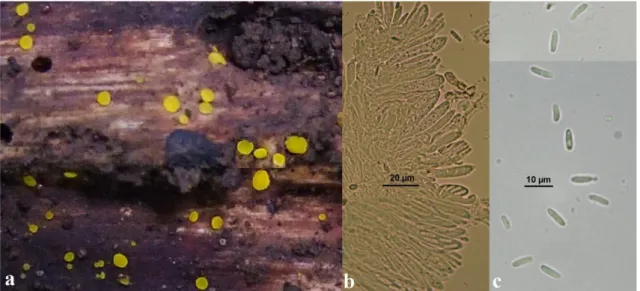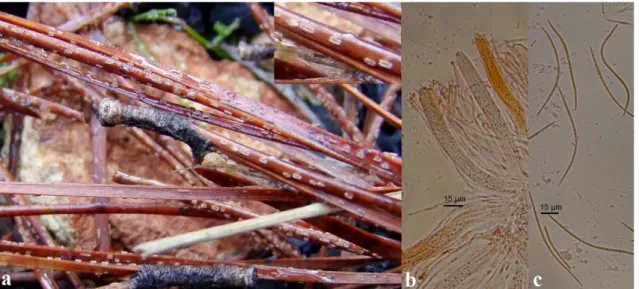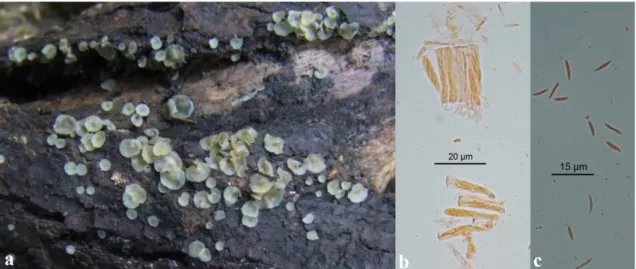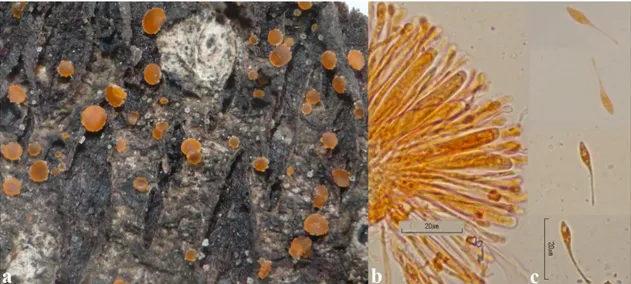46
New additions to Turkish Helotiales and Orbiliales
Abdullah KAYA1*, Yasin UZUN1, İbrahim Halil KARACAN2, Semiha YAKAR1 1*Karamanoğlu Mehmetbey University, Faculty of Science, Karaman, 70100, Turkey2Ömer Özmimar Religious Anatolian High School, Gaziantep, 27220, Turkey *Corresponding author: kayaabd@hotmail.com
Received Date: 06.02.2017 Accepted Date: 05.02.2018
Abstract
Aim of study: Though hundreds of studies were conducted on the biodiversity of Turkish fungi, the
mycobiota has not been determined yet. Probably thousands of researches are required to determine the overall mycobiota of Turkey. This study were also carried out upon this purpose and aims to make a contribution to the mycobiota of Turkey by adding new genera and species records.
Area of study: This study was carried out within the boundaries of İslahiye, Nurdağı and Şehitkamil
districts of Gaziantep province.
Material and Methods: The macrofungi samples were collected from İslahiye, Nurdağı and
Şehitkamil districts in the years 2014 and 2015. After obtaining required field data, they were transferred to the fungarium and investigated in terms of macroscopy and microscopy. Then they were identified with the help of relevant literature.
Main results: Five ascomycetous fungi species; Bisporella sulfurina (Quél.) S.E. Carp. (Helotiaceae
Rehm), Lachnum fuscescens (Pers.) P. Karst. (Lachnaceae Raitv.), Cyclaneusma niveum (Pers.) DiCosmo, Peredo & Minter (Marthamycetaceae H.O. Baral, G. Lantz, Hustad & Minter), Hyalorbilia
inflatula (P. Karst.) Baral & G. Marson and Orbilia aristata (Velen.) Velen. (Orbiliaceae Nannf.), within
the orders Helotiales and Orbiliales were determined. Tracing the current literature the taxa were found to be new for the mycobiota of Turkey.
Research highlights: Macrofungal biodiversity studies are necessary to be able to determine the
mycobiota of Turkey.
Keywords: New records, Helotiales, Orbiliales, Gaziantep, Turkey.
Türkiye Helotiales’leri ve Orbiliales’lerine yeni ilaveler
ÖzetÇalışmanın amacı: Türkiye mantarlarının biyoçeşitliliği ile ilgili yüzlerce çalışma yapılmış olmasına
ragmen, mikobiyota henüz ortaya konamamıştır. Türkiye mikobiyotasının belirlenmesi için belki de binlerce araştırma yapılmalıdır. Bu çalışma da bu amaca yönelik olarak gerçekleştirilmiş olup yeni cins ve tür kayıtları ilavesiyle Türkiye mikobiyotasına katkı sağlamayı amaçlamaktadır.
Çalışma alanı: Bu çalışma Gaziantep’in İslahiye, Nurdağı ve Şehitkamil ilçe sınırları içinde
gerçekleştirilmiştir.
Materyal ve Yöntem:Makromantar örnekleri 2014 ve 2015 yıllarında İslahiye, Nurdağı ve Şehitkamil ilçelerinden toplanmıştır. Gerekli arazi verileri derlendikten sonra, örnekler fungaryuma taşınıp, makroskobik ve mikroskobik incelemeleri gerçekleştirilmiş. Sonra da ilgili literatür yardımıyla teşhisleri yapılmıştır.
Temel Sonuçlar: Helotiales ve Orbiliales takımları içinde yer alan beş askomiset mantar türü; Bisporella sulfurina (Quél.) S.E. Carp. (Helotiaceae Rehm), Lachnum fuscescens (Pers.) P. Karst.
(Lachnaceae Raitv.), Cyclaneusma niveum (Pers.) DiCosmo, Peredo & Minter (Marthamycetaceae H.O. Baral, G. Lantz, Hustad & Minter), Hyalorbilia inflatula (P. Karst.) Baral & G. Marson ve Orbilia
aristata (Velen.) Velen. (Orbiliaceae Nannf.), Türkiye mikobiyotası için yeni kayıt olarak verilmiştir. Araştırma vurguları: Türkiye mikobiyotasının belirlenebilmesi için makromantar biyoçeşitliliği
çalışmaları gereklidir.
Anahtar kelimeler: Yeni kayıtlar, Helotiales, Orbiliales, Gaziantep, Türkiye.
This work is licensed under a Creative Commons Attribution-NonCommercial 4.0 International License.
Kastamonu Uni., Orman Fakültesi Dergisi, 2018, 18 (1): 46-52 Kaya et al. Kastamonu Univ., Journal of Forestry Faculty
47
Introduction
Helotiales Nannf. and Orbiliales Baral, O.E. Erikss. are two orders within the phylum Ascomycota. Helotiales contains approximately 3880 taxa within 501 genera and 10 families and the members are characterized with stipitate or sessile, disc formed, cup like or more rarely convex apothecial ascomata, thin walled asci with unseparable wall, and spores which are symmetric in longitude, generally hyaline, usually smooth, simple or septate in across (Akata et al., 2016a). On the other hand the species of Orbiliales are characterized by generally convex, brightly coloured or translucent apothecial ascomata, small asci, small, hyaline, ovoid to ellipsoid, usually curved or even helical and mostly aseptate ascospores, and it contains 288 taxa belonging to 12 genera within the family Orbiliaceae Nannf. (Cannon and Kirk, 2007; Kirk et al., 2008).
Currently 70 taxa of Helotiales within 43 genera exist in Turkey (Sesli and Denchev, 2008; Kaya, 2009; Akata and Kaya 2010; 2012; 2013; Akata et al., 2014a; 2014b; Uzun et al., 2014; 2015a; 2015b; Güngör et al., 2015a; 2015b; Akata et al., 2016b; Akçay and Uzun, 2016; Doğan and Kurt, 2016; Öztürk et al., 2016; Uzun et al., 2017a) while only five members of Orbiliales, Orbilia auricolor (A. Bloxam) Sacc., Orbilia curvatispora Boud., Orbilia luteorubella (Nyl.) P. Karst., Orbilia sarraziniana Boud. and Orbilia xanthostigma (Fr.) Fr. (Akata and Doğan, 2015; Uzun et al., 2017b), have so far been recorded from Turkey.
The present study aims to make a contribution to Turkish mycobiota.
Materials and methods
Samples of macrofungi were collected from İslahiye, Nurdağı and Şehitkamil districts of Gaziantep province between 2014 and 2015. During field studies the fruiting bodies were photographed where they grow and required characteristics for identification about their ecology and morphology were noted. Micromorphological studies were carried out under Nikon Eclipse Ci-S
trinocular light microscope. As chemical reagents or investigation media, distilled water, Meltzer’s reagent and Congo red were used. Identification of the samples were perfored by comparing the obtained data with DiCosmo et al. (1983), Breitenbach and Kränzlin (1984), Wang (2005), Hou et al. (2006), Zhang et al. (2009), Medel et al. (2013), Guo et al. (2014), Ivanová (2015) and Quijada et al. (2015). Dried fruit bodies are kept at Karamanoğlu Mehmetbey University, Kamil Özdağ Science Faculty, Department of Biology.
Results
Kirk et al. (2008) and Index fungorum (www.indexfungorum.org: accessed 20 December 2016) were followed for the systematics of the taxa
Helotiales Nannf. Helotiaceae Rehm
Bisporella sulfurina (Quél.) S.E.Carp.
(1974).
Syn: Calycella sulfurina (Quél.) Boud.,
Calycella sulfurina var. brassicae Grélet, Calycella sulfurina (Quél.), Boud., var. sulfurina, Calycina sulfurina (Quél.) Kuntze, Helotium sulfurinum Quél.
Macroscopic and microscopic features:
Apothecia 0.5-1.5 mm in diameter, cup, saucer to plate-shaped, bright to sulfur-yellow, hymenial surface smooth (Figure 1a). Asci 60-90 × 4-6 µm, cylindric clavate, conical at the apex, eight spored, spores usually biseriate (Figure 1b). Paraphyses filiform. Ascospores 8-12 × 2 µm, elliptical-fusiform, smooth, hyaline, mostly with one septum (Figure 1c). Bisporella sulfurina usually found on dead branches often in small dense clusters, and always associated with old fruit-bodies of fungal species belonging to the Xylariales (Hubregtse, 2017).
Specimen examined: TURKEY —
Gaziantep: İslahiye, Kozdere village, on dead Quercus L. sp. twigs, 37°06′N-36°39′E, 550m, 15.03.2014, K.8642; Şehitkamil, Yeşilce village, 37°10′N-37°12′E, 1045 m, 29.11.2014, K.10738; 12.04.2015, K. 11706.
48
Figure 1. Bisporella sulfurina: a. ascocarps, b. asci and paraphyses, c. ascospores.
Lachnaceae Raitv.
Lachnum fuscescens (Pers.) P.Karst.
(1885).
Syn: Atractobolus brunneolus (Desm.)
Kuntze, Atractobolus fuscescens (Pers.) Kuntze, Brunnipila fagicola (W.Phillips) Baral, Brunnipila fuscescens (Pers.) Baral, Dasyscyphus brunneolus (Desm.) Sacc., Dasyscyphus brunneolus (Desm.) Sacc., var. brunneolus, Dasyscyphus brunneolus var. fagicola (W.Phillips) Sacc., Dasyscyphus fagicola (W.Phillips) Le Gal, Dasyscyphus fuscescens (Pers.) Gray, Dasyscyphus fuscescens var. fagicola (W.Phillips) Dennis, Dasyscyphus fuscescens (Pers.) Gray, var. fuscescens, Lachnea brunneola (Desm.) Gillet, Lachnea brunneola var. brasiliensis Bres., Lachnea brunneola (Desm.) Gillet, var. brunneola, Lachnella brunneola (Desm.) Sacc., Lachnella brunneola (Desm.) Sacc., var. brunneola, Lachnella brunneola var. fagicola W.Phillips, Lachnella fuscescens (Pers.) W.Phillips, Lachnum brunneolum (Desm.) P.Karst., Lachnum fagicola (W.Phillips) Raitv., Lachnum fuscescens (Pers.) P.Karst., var. fuscescens, Peziza brunneola Desm., Peziza fuscescens Pers., Stictis fagicola W. Phillips.
Macroscopic and microscopic features:
Apothecia 0.3-1.3 mm in diameter, cup to saucer-shaped, short stipitate, white to ocher-whitish, covered with whitish to light-brownish hairs which are 80-90 µm long, septate, finely encrusted and with a crystal
structure at the tips (Figure 2c)., hymenial surface smooth (Figure 2a). Asci 40-60 × 4-6.5 µm, cylindrical, eight spored, usually spores irregularly biseriate (Figure 2b). Paraphyses lanceolate. Ascospores 7-9 × 2-2.5 µm, fusiform, smooth, hyaline (Figure 2d). Lachnum fuscescens grows on fallen leaves of Fagus L. and Quercus L. (Breitenbach and Kränzlin, 1984).
Specimen examined: TURKEY —
Gaziantep: Nurdağı, Olucak village, on dead Quercus L. sp. twigs, 37°10′N-36°40′E, 950 m, 10.04.2015, K.11681.
Marthamycetaceae H.O.Baral, G.Lantz,
Hustad & Minter
Cyclaneusma niveum (Pers.) DiCosmo,
Peredo & Minter (1983).
Syn: Lophodermium gilvum Rostr.,
Naemacyclus niveus (Pers.) Fuckel ex Sacc., Propolis nivea (Pers.) Fr., Schmitzomia nivea (Pers.) De Not., Stictis nivea Pers.
Macroscopic and microscopic features:
Apothecia 1-1.5 mm in diameter, subepidermal, elliptical when fully open, raising the epidermis forming two parallel longitudinal barriers, hymenial surface smooth, waxy (Figure 3a). Asci 110-140 × 11-15 µm, subcylindrical-clavate, eight spored. Paraphyses cylindrical, some forked, thickened at the apex (Figure 3b). Ascospores 80-130 × 2.5-3.5 µm, filiform to needle-shaped, smooth, septate, slightly curved (Figure 3c). Cyclaneusma niveum
Kastamonu Uni., Orman Fakültesi Dergisi, 2018, 18 (1): 46-52 Kaya et al. Kastamonu Univ., Journal of Forestry Faculty
49 grows on needles of Pinus nigra Arnold, P. halepensis Miller and P. pinaster Aiton (Gadgil, 1984).
Specimen examined: TURKEY —
Gaziantep: Şehitkamil, Dülükbaba city park, pine forest, on dead Pinus brutia L. needles, 37°07′N-37°19′E, 1110 m, 06.12.2014, K. 10934.
Figure 2. Lachnum fuscescens: a. ascocarps, b. asci and paraphyses, c. hairs, d. ascospores
Orbiliales Baral, O.E. Erikss. Orbiliaceae Nannf.
Hyalorbilia inflatula (P.Karst.) Baral &
G.Marson (2001).
Syn: Calloria inflatula (P.Karst.) W.Phillips,
Hyalinia inflatula (P.Karst.) Boud., Orbilia inflatula (P.Karst.) P.Karst., Orbilia inflatula (P.Karst.) P.Karst., var. inflatula, Orbilia inflatula var. lonicerae Rehm, Peziza inflatula P.Karst.
Macroscopic and microscopic features:
Apothecia 1-3 mm in diameter, cupulate, disc
to plate-shaped, sessile or short stipitate, water-whitish, translucent, hymenial surface smooth (Figure 4a). Asci 23-26 x 3.5-4 μm, cylindrical, truncate, rounded at the apex, eight spored (Figure 4b). Paraphyses cylindrical, hyaline. Ascospores 4-7 × 0.8-1.2 µm, cylindric to fusiform, straight or slightly curved, hyaline (Figure 4c). Hyalorbilia inflatula grows on rotten wood and bark of woody plants (Liu et al., 2006).
50
Figure 4. Hyalorbilia inflatula: a. ascocarps, b. asci and paraphyses, c. ascospores.
Specimen examined: TURKEY —
Gaziantep: İslahiye, Tandır village, Huzurlu high plateau, mixed forest, on Quercus L. sp. twigs, 36°57′N-36°30′E, 1140 m, 01.11.2014, K.10385.
Orbilia aristata (Velen.) Velen. (1947).
Syn: Orbilia occulta var. aristata Velen. Macroscopic and microscopic features:
Apothecia 0.5-1.5 mm in diameter, disc shaped, sessile, centrally attached to the substrate, dark yellow, orange to orange brown, margin crenulate, hymenial surface smooth (Figure 5a). Asci 45-55 × 6-8 µm, cylindrical to clavate, eight spored. Paraphyses cylindrical, distinctly enlarged at the apex (Figure 5b). Ascospores 16-22 × 2.2-3.6 µm, composed of a head and a tail, head ellipsoid-naviculiform, tail cylindrical, some slightly bulbous at the end (Figure 5c). Orbilia aristata grows on bark of woody plants.
Specimen examined: TURKEY —
Gaziantep: Nurdağı, Belpınar village, on bark of dead Pinus brutia L. twigs, 37°12′N-36°46′E, 540 m, 09.03.2014, K.8596.
Discussion
With this study, five new fungi species, Bisporella sulfurina (Quél.) S.E.Carp., Lachnum fuscescens (Pers.) P.Karst. Cyclaneusma niveum (Pers.) DiCosmo,
Peredo & Minter, Hyalorbilia inflatula (P. Karst.) Baral & G.Marson and Orbilia aristata (Velen.) Velen., belonging to the families Helotiaceae, Lachnaceae, Marthamycetaceae and Orbiliaceae within the orders Helotiales and Orbiliales, were given as new records for the mycobiota of Turkey. Among them, Hyalorbilia inflatula is the first member of the genus Hyalorbilia Baral & G. in Turkey.
With the addition of three helotioid and two orbilioid records, current species number of Helotiaceae, Lachnaceae, Marthamycetaceae (Helotiales) and Orbiliaceae (Orbiliales) in Turkey increased to 19, 12, 2 and 7 respectively.
Although the color of Bisporella sulfurina is quite characteristic, it is easy to confuse it with B. citrina (Batsch) Korf & S.E. Carp. or some yellow members of Hymenoscyphus Gray, but B. citrina has larger apothecia and the members of Hymenoscyphus differs with distinct stipes.
Though Cyclaneusma niveum is similar to Cyclaneusma minus (Butin) DiCosmo, Peredo & Minter, it has has larger ascomata, asci and ascospores than C. minus (Ivanová, 2015).
Orbilia aristata is similar to O. brevicauda Y.Zhang, Baral & K.Q.Zhang in spore shape, but differs from O. brevicauda with larger ascospores.
Kastamonu Uni., Orman Fakültesi Dergisi, 2018, 18 (1): 46-52 Kaya et al. Kastamonu Univ., Journal of Forestry Faculty
51
Figure 5. Orbilia aristata: a. ascocarps, b. asci and paraphyses, c. ascospores.
Acknowledgement
The authors would like to thank TÜBİTAK for supporting the project (212T112) financially.
References
Akata, I., Kaya, A. (2010). A New Jelly Ascomycetous Genus Record for Turkish Mycobiota. SDU Journal of Science, 5(1), 1-4.
Akata, I., Kaya, A. (2012). Two New Additions to Turkish Ascomycota. International Journal of Botany, 8(2), 79-81.
Akata, I., Kaya, A. (2013). Two earth-tongue genera new for Turkey. Mycotaxon, 125, 87-90.
Akata, I., Kaya, A., Uzun, Y. (2014a). Two New Lachnum Records for Turkish Mycobiota. Journal of Applied Biological Sciences, 8(1), 28-30.
Akata, I., Kaya, A., Uzun, Y. (2014b). Macromycetes determined in Yomra (Trabzon) district. Turkish Journal of Botany, 38(5), 999-1012.
Akata, I., Doğan, H.H. (2015). Orbiliaceae For Turkish Ascomycota: Three New Records. Bangladesh Journal of Botany, 44(1), 91-95.
Akata, I., Kaya, A., Uzun, Y. (2016a). Two New Genus Records for Turkish Helotiales. Kastamonu University Journal of Forestry Faculty, 16(1), 131-134.
Akata, I., Uzun, Y., Kaya, A. (2016b). Macrofungal diversity of Zigana
Mountain (Gümüşhane/Turkey).
Biological Diversity and Conservation, 9(2), 57-69.
Akçay, M.E, Uzun, Y. (2016). Belonidium mollissimum (Lachnaceae): A New Record for The Mycota of Turkey. The Journal of Fungus, 7(2), 118-121.
Breitenbach, J., Kränzlin, F. (1984). Fungi of Switzerland, Vol. 1. Lucerne, Verlag Mykologia.
Cannon, P.F., Kirk, P.M. (2007). Fungal Families of the World. Wallingford, UK: CAB International.
DiCosmo, F., Peredo, H., Minter, D.W. (1983). Cyclaneusma gen. Nov., Naemacyclus and Lasiostictis, a nomenclatural problem resolved. European Journal of Forest Pathology, 13(4), 206-212.
Doğan, H.H., Kurt, F. (2016). New macrofungi records from Turkey and macrofungal diversity of Pozantı-Adana. Turkish Journal of Botany, 40(2), 209-217.
Gadgil, P.D. (1984). Cyclaneusma (Naemacyclus) Needle-Cast Of Pinus radiata in New Zealand 1: Biology Of Cyclaneusma minus. New Zealand Journal of Forestry Science, 14(2), 179-96.
Guo, J., Li, S., Yang, L., Yang, J., Ye, T., Yang, L. (2014). New records and new
52 distribution of known species in the family Orbiliaceae from China. African Journal of Microbiology Research, 8(34), 3178-3190.
Güngör, H., Şen, İ., Allı, H., Solak, M.H. (2015a). Two new Ascomycete records for Turkish Mycota. Biological Diversity and Conservation, 8(1), 19-21.
Güngör, H., Çolak, Ö.F., Güngör Yaratanakul, M., Solak, M.H. (2015b). New Ascomycete (Geoglossum umbratile, Peziza lobulata) records for Turkey. Biological Diversity and Conservation, 8(2), 1-3.
Hou, C.L., Gao, J., Piepenbring, M. (2006). Four rhytismataceous ascomycetes on needles of pine from China. Nova Hedwigia, 83(3-4), 511-522.
Hubregtse, J. (2017). Fungi In Australia, Rev. 2.0, E-published by the Field Naturalists Club of Victoria Inc., Blackburn, Victoria, Australia.
Index Fungorum. (2016).
http://www.indexfungorum.org/Names/N ames.asp. Accessed 20 December 2016. Ivanová, H.Ç. (2015). Fungi associated with
a decline of Pinus nigra in urban greenery. Acta Fytotechnica et Zootechnica, 18(2), 36-43.
Kaya, A. (2009). Macromycetes of Kahramanmaraş Province (Turkey). Mycotaxon, 108, 31-34.
Kirk, P.M., Cannon, P.F., Minter, D.W., Stalpers, J.A. (2008). Dictionary of the fungi, 10th ed. CAB International, 771 p., Wallingford, UK.
Liu, B., Liu, X.Z., Zhuang, W.Y., Baral, H.O. (2006). Orbiliaceous fungi from Tibet, China. Fungal Diversity, 22, 107-120.
Medel, R., Moreles, O., Moral, R.C, Cáceres R. (2013). New ascomycete records from Guatemala. Mycotaxon, 124, 73-85. Sesli, E., Denchev, C.M. (2008). Checklists
of the myxomycetes, larger ascomycetes, and larger basidiomycetes in Turkey. Mycotaxon, 106: 65–67. + [complete version, 1-136, new version uploaded in February 2014].
Quijada, L., Baral, H.O., Tejera, E.B. (2015). Diversity of Hyalorbilia (Orbiliales) in the
Macaronesian Region. Nova Hedwigia, 100(1-2), 1-14.
Öztürk, Ö., Doğan, H.H., Şanda, M.A. (2016). Some new additions to Turkish mycobiota from Sakarya region. Biological Diversity and Conservation, 9(1), 97-100.
Uzun, Y., Acar, İ., Akçay, M.E., Akata, I., (2014). Additions to the Turkish Discomycetes. Turkish Journal of Botany, 38(3), 617-622.
Uzun, Y., Kaya, A., Karacan, İ.H., Kaya, Ö.F., Yakar, S. (2015a). Neobulgaria Petr. and Trichopeziza Fuckel, Two New Genus Record for Turkish Lachnaceae. The Journal of Fungus, 6(2), 58-61. Uzun, Y., Kaya, A., Karacan, İ.H., Kaya,
Ö.F., Yakar, S. (2015b). Macromycetes
determined in Islahiye
(Gaziantep/Turkey) district. Biological Diversity and Conservation, 8(3), 209-217.
Uzun, Y., Kaya, A., Karacan, İ.H., Yakar, S. (2017a). New Additions to Turkish Hyaloscyphaceae. The Journal of Fungus, 8(1), 13-19.
Uzun, Y., Acar, İ., Akçay, M.E., Kaya, A. (2017b). Contributions to the macrofungi of Bingöl, Turkey. Turkish Journal of Botany, 41(5), 516-534.
Wang, Y.Z. (2005). Three discomycetes (Helotiaceae) new to Taiwan. Fungal Science, 20 (1, 2), 41-45.
Zhang, Y., Yu, Z.F., Baral, H.O., Mo, M.H., Zhang, K.Q. (2009). New species and new Chinese records of the genus Orbilia (Orbiliaceae, Ascomycota) from Yunnan, China. Fungal Diversity, 36, 141-153.



